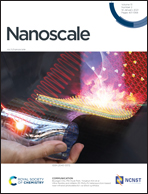Suppression of metal-to-insulator transition using strong interfacial coupling at cubic and orthorhombic perovskite oxide heterointerfaces†
Abstract
A quasi-two-dimensional electron gas (2DEG) evolved at the LaAlO3 (LAO)/SrTiO3 (STO) interface has attracted significant attention, because the insertion of perovskite titanates can tune the 2DEG conductivity. However, this depends on the Ti–O–Ti bonding angle and structural symmetry. In this study, we controlled the octahedral tilt of the LAO/CaTiO3 (CTO) interface by heterostructuring it with CTO grown on STO substrates of various thicknesses. The 2DEG was maintained when the thickness of CTO was below the critical thickness of 5 unit cells (uc); however, it was suppressed when the CTO thickness was above the critical thickness. High-angle annular dark-field (HAADF) scanning transmission electron microscopy (STEM) combined with integrated differential phase contrast (iDPC) STEM imaging was used to visualize the TiO6 octahedral tilt propagation and symmetry of the 5 uc and 24 uc CTO films. The symmetry of the 5 uc CTO film resembled that of the STO substrate, whereas the octahedral tilt propagated in the 24 uc CTO film due to the structural relaxation. These results show that the interface engineering of the octahedral tilt can enable or suppress the formation of the 2DEG in perovskite oxides.



 Please wait while we load your content...
Please wait while we load your content...